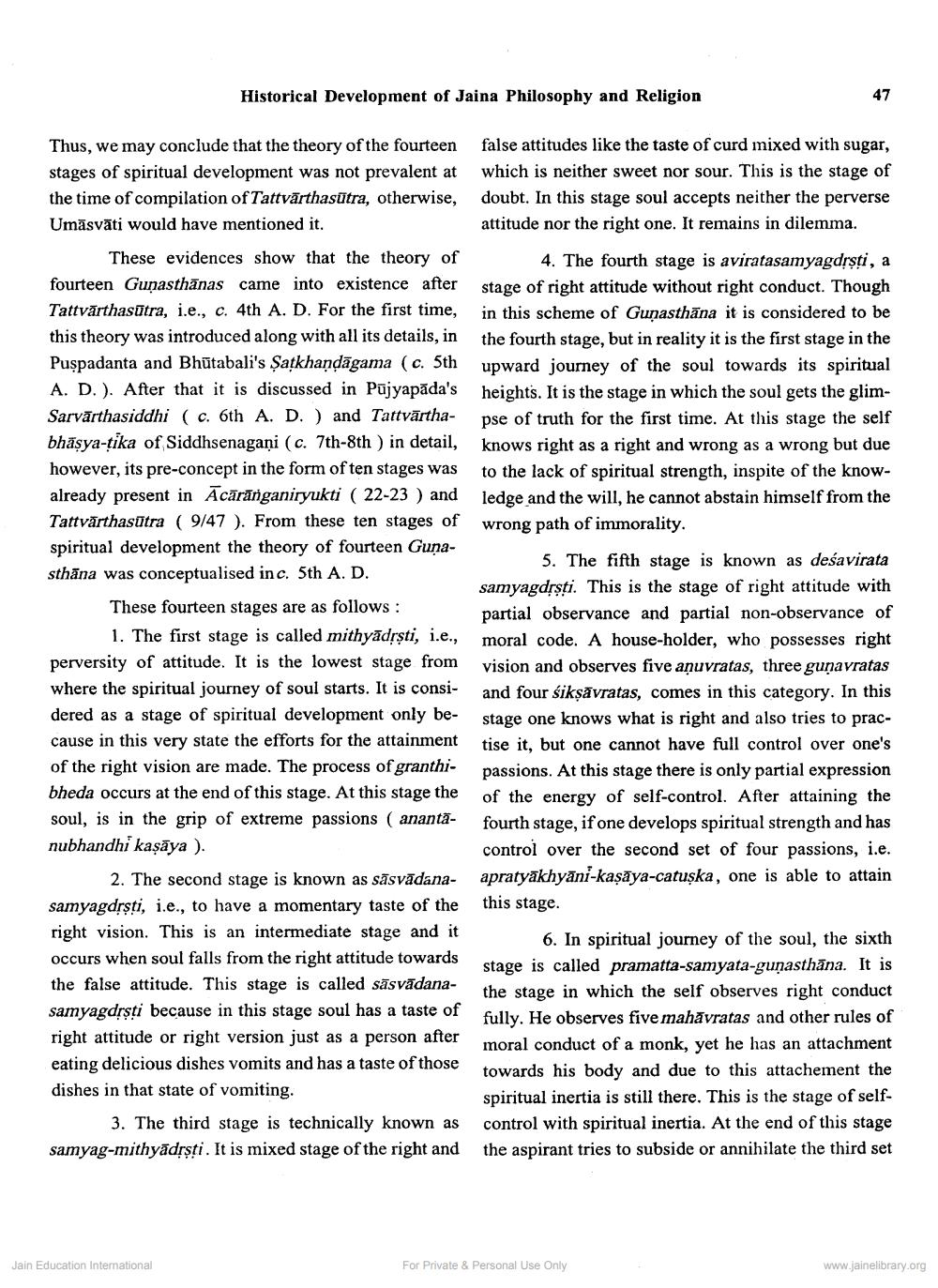________________
Historical Development of Jaina Philosophy and Religion
Thus, we may conclude that the theory of the fourteen stages of spiritual development was not prevalent at the time of compilation of Tattvarthasutra, otherwise, Umāsväti would have mentioned it.
These evidences show that the theory of fourteen Gunasthānas came into existence after Tattvārthasūtra, i.e., c. 4th A. D. For the first time, this theory was introduced along with all its details, in Puspadanta and Bhütabali's Satkhandagama (c. 5th A. D.). After that it is discussed in Pujyapada's Sarvarthasiddhi ( c. 6th A. D. ) and Tattvärthabhāṣya-tika of Siddhsenagani (c. 7th-8th) in detail, however, its pre-concept in the form of ten stages was already present in Acaranganiryukti (22-23) and Tattvärthasūtra (9/47). From these ten stages of spiritual development the theory of fourteen Gunasthāna was conceptualised in c. 5th A. D.
These fourteen stages are as follows:
1. The first stage is called mithyadṛṣti, i.e., perversity of attitude. It is the lowest stage from where the spiritual journey of soul starts. It is considered as a stage of spiritual development only because in this very state the efforts for the attainment of the right vision are made. The process of granthibheda occurs at the end of this stage. At this stage the soul, is in the grip of extreme passions (anantănubhandhi kaşaya).
3. The third stage is technically known as samyag-mithyādṛsti. It is mixed stage of the right and
Jain Education International
5. The fifth stage is known as deśavirata samyagdṛṣṭi. This is the stage of right attitude with partial observance and partial non-observance of moral code. A house-holder, who possesses right vision and observes five aṇuvratas, three gunavratas and four sikṣāvratas, comes in this category. In this stage one knows what is right and also tries to practise it, but one cannot have full control over one's passions. At this stage there is only partial expression of the energy of self-control. After attaining the fourth stage, if one develops spiritual strength and has control over the second set of four passions, i.e.
2. The second stage is known as såsvädana- apratyäkhyani-kaṣāya-catuska, one is able to attain. samyagdṛsti, i.e., to have a momentary taste of the right vision. This is an intermediate stage and it occurs when soul falls from the right attitude towards the false attitude. This stage is called sāsvādana
samyagdrsti because in this stage soul has a taste of right attitude or right version just as a person after eating delicious dishes vomits and has a taste of those dishes in that state of vomiting.
47
false attitudes like the taste of curd mixed with sugar, which is neither sweet nor sour. This is the stage of doubt. In this stage soul accepts neither the perverse attitude nor the right one. It remains in dilemma.
4. The fourth stage is aviratasamyagdṛsti, a stage of right attitude without right conduct. Though in this scheme of Guṇasthana it is considered to be the fourth stage, but in reality it is the first stage in the upward journey of the soul towards its spiritual heights. It is the stage in which the soul gets the glimpse of truth for the first time. At this stage the self knows right as a right and wrong as a wrong but due to the lack of spiritual strength, inspite of the knowledge and the will, he cannot abstain himself from the wrong path of immorality.
this stage.
6. In spiritual journey of the soul, the sixth stage is called pramatta-samyata-gunasthana. It is the stage in which the self observes right conduct fully. He observes five mahāvratas and other rules of moral conduct of a monk, yet he has an attachment towards his body and due to this attachement the spiritual inertia is still there. This is the stage of selfcontrol with spiritual inertia. At the end of this stage the aspirant tries to subside or annihilate the third set
For Private & Personal Use Only
www.jainelibrary.org




